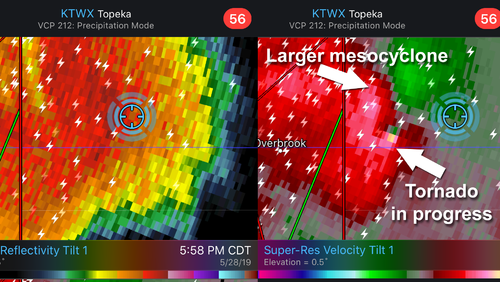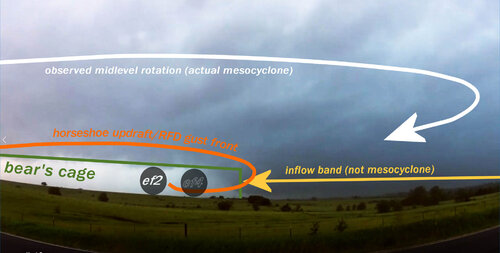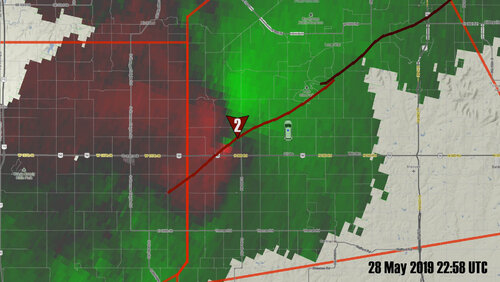I hope to share a video analysis of this incident soon. Much of it may contradict statements from SLT staff, Jon Davies' analysis, and comments here. I have reached out to the Hills for help in the process, but have not received any. I have received much help from some of the impacted SLT guests and other chasers that were in the area. It appears the group traveled north into the storm's inflow notch, north of the bulk of the RFD core and (unknown) tornado path. They then turned around and went back south. They did not have time to clear the RFD core, but instead were almost immediately enveloped by it, and then impacted by a rain wrapped tornado less than two minutes later. The location of the tornado was characteristically typical of a large HP supercell. The tornado was long track and had been in progress for minutes and miles. The storm was well warned with ~20 minutes of lead time thanks to the velocity couplet, and visual recognition of its structure was apparent including the RFD precipitation core marking the storm's Bear's Cage, and inflow band extending to the north. The portion of the inflow band extending into the notch does not appear to be associated with the low level rotation of the primary mesocyclone, or the area from which the later EF4 would spawn. The EF4 appears to have spawned from behind the RFD gust front, in a similar position to the previous tornado relative to the parent structure, and again in a characteristic manner of HP supercells. The hazardous regions were visually recognizable and avoidable. I'm not going to make any accusations or speculate on the motive as to why such a course was taken. My hopes are that we can help avoid some future injuries and fatalities.
I'm sharing this here so that you can speak up and correct me if needed. This is your chance to do so before this video gets published. I'll likely share a draft with folks for critique too.
it just seems odd there are some who think there should be no risks when the subject is chasing tornadoes. I guess I'm more of the mindset that safety is not the thing that is most important to tour individuals.
I know many people injured and one person that died getting on a horse. But none of them stressed beforehand over falling off. Tornadoes are scary. Isn't that the big difference?
Granted, the history of storm chasing has a much better safety record than auto racing or mountain climbing, but similar dangers existed then, and they exist now. You're signing up to see a phenomena that kills multiple people every year.
... the expectation of absolute safety cannot be made in this case. While technology has made road cars, race cars, mountain climbing gear, and yes, storm chasing, safer, nothing is ever going to completely remove the risk associated. There will still be highway deaths, there will still be racing crashes, people will still be frozen into the side of Everest, and there will still be chasing incidents where people are injured or killed.
It's not about storm chasing being risky. It's that we have identified risks that are wholly unnecessary to accomplishing the goals of the activity, and identified ways to avoid the dangers associated with these risks. This was accomplished by sharing decades of knowledge obtained through trial and error, risky experimentation, and even scientific study. This is how everything in life works. It's why we let babies attempt to walk, knowing they will fall and hurt themselves many times in the process, AND YET we also put baby gates in front of the stairs. It's why you don't stand behind a horse. It's why we wear a helmet when horseback riding, racing cars, or rock climbing and yet these activities still result in fatalities. It's why we wear seat belts.
It's why we don't drive blind into the Bear's Cage of a tornado warned HP.
Not because this assures 100% safety in these activities. But because this prevents needless death and injury. Just because you haven't heeded these precautions dozens of times in the past and gotten away with it, does not mean these precautions do not prevent needless death and injury. As dangerous as some of these activities can be, they all have hard earned safety lessons and precautions that responsible people who engage in these activities follow.
It's just going to happen, no changing that.
Yes, it's going to happen again. Let's not let that dissuade us from promoting safe and responsible storm chasing practices, even if risks remain that injure people, even if people don't take these hard earned safety lessons to heart and are needlessly injured or killed as a result.
I have done the same maneuver with Roger a number of other times, and have done it on several other chases over the years.
Now, if it happens again....
This is it happening again. What we're finding out here is that there's a long history of this behavior. And by "this behavior" I mean taking an inexperienced group/caravan into the Bear's Cage of a tornado warned HP: Close calls, even from the same group (22 May 2011 Joplin, 4 June 2015 Simla); Minor incidents with other groups (Wakita, OK 10 May 2010, Beaver Crossing, NE 11 May 2014); Even catastrophic casualties that should have driven this home for everyone (31 May 2013 El Reno).
Can you point to me a source of information - a manual, guide, course, tutorial, textbook, lecture, science paper, article, blog post, web page - one widely recognized in storm chasing as authoritative and credible - that declares a general HP RFD transect as a 100% no-go scenario? Can you provide any evidence that the tour owner should have known this maneuver brought with it a high risk of what occurred?
In my perfect world waivers would cover almost impossible to detect tornadoes in what appears to be, from available radar data, surging rfd. But I don't live in a perfect world.
Tornadoes buried in the RFD gust front are rare, but do occur
2.) Strong tornadoes that have no discernable couplet on radar velocity imagery can exist within RFD.
You can come at me all you want about #2; say to me duh, you should already have known that. I wonder though if you knew that before this happened.
The above is what I find most baffling in all of this. The RFD core on an HP supercell is the Bear's Cage. That circular green region is the rain wrapping around the mesocyclone, forming the bars of the Bear's Cage. It is the ball at the end of the hook. It is the most likely place for a significant tornado. It is the most dangerous part of the storm. I can point you to dozens and dozens of photos and videos showing significant tornadoes buried in the RFD core of an HP supercell. There are indeed books, blog posts, websites, lectures, and even scientific publications (SLS '14 had an entire section devoted to El Reno) highlighting the dangers associated with the Bear's Cage region and HP supercells. We've known this for decades thanks to publications from folks like Doswell, Stormtrack, and even chase video from NSSL going back to the 70's and 80's. Roger's video and shots from other nearby chasers on the 28 May 2019 Lawrence storm clearly show textbook Bear's Cage structure on the RFD gust front of an HP supercell.
It may be as simple as a pattern of core punching the Bear's Cage until luck finally ran out. There *shouldn't be* any mystery to this. That there might be to some is astounding to me. It should be painfully obvious once one is presented with video of the approaching storm structure and the radar. That some who built storm chasing as we know it today might even try to undermine these safety lessons and undo what we've learned is disheartening.
 )
)


